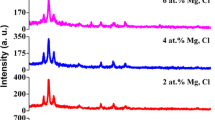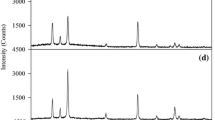Abstract
The CdS:Cl thin films have been prepared using thermally evaporated, CdCl2-mixed CdS powder at 200°C substrate temperature. The percentage of CdCl2 in the mixture varied from 0% to 0.20%. The electrical properties and the grain size of the deposited films were investigated. The results show that light doping, resistivity, carrier concentration, and mobility follow Seto’s model for polycrystalline material. However, with heavy doping, these properties undergo a saturation trend. The saturation behavior can be understood in terms of the rapid formation of the A-center complexes in the films. The deposited films were annealed at 250°C and 300°C. The resistivity of pure and lightly doped CdS films increased with annealing temperature, whereas carrier concentration and mobility in these films decreased. However, for the higher doping concentrations, the resistivity decreased, whereas carrier concentration and mobility showed improvement. These changes in electrical properties of the deposited films with annealing and doping concentration are attributed to a reduction in the lattice defect sites in CdS upon annealing. The experimental results are interpreted in terms of a modified version of Seto’s model for polycrystalline materials.
Similar content being viewed by others
References
M. Tsuji, T. Aramoto, H. Ohyama, T. Hibino, and K. Omura, Jpn. J. Appl. Phys. 39, 3902 (2000).
E. Ebenezer, K.R. Murali, M.J. Chockalingam, and V.K. Venkatesan, J. Mater. Sci. 23, 3861 (1988).
I. Gunal and M. Parlak, J. Mater. Sci. Mater. Electron. 8, 9 (1997).
K. Kasai, H. Yamada, Y. Kashiwaba, and H. Saito, Tech. Rep. Iwate Univ. 7, 51, (1973).
M.K. Karanjai and D. Dasgupta, J. Phys. D: Appl. Phys. 21, 1769 (1988).
A. Romeo, D.L. Bätzner, H. Zong, C. Vignli, and A.N. Tiwari, Solar Energy Mater. Solar Cells 67, 311 (2001).
J.Y.W. Seto, J. Appl. Phys. 46, 5247 (1975).
S.-H. Wei, S.B. Zhang, and A. Zunger, J. Appl. Phys. 87, 1304 (2000).
M.V. Garcia-Cuenca, J.L. Morenza, and J. Esteve, J. Appl. Phys. 56, 1738 (1984).
P.C. Pande, G.J. Russell, and J. Woods, Thin Solid Films 121, 85 (1984).
Author information
Authors and Affiliations
Rights and permissions
About this article
Cite this article
Abu-Safe, H.H., Hossain, M., Naseem, H. et al. Chlorine-doped CdS thin films from CdCl2-mixed CdS powder. J. Electron. Mater. 33, 128–134 (2004). https://doi.org/10.1007/s11664-004-0282-8
Received:
Accepted:
Issue Date:
DOI: https://doi.org/10.1007/s11664-004-0282-8




